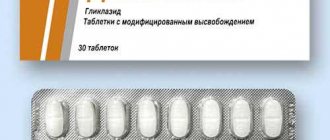Siofor: instructions for use
| Therapeutic effect | Siofor helps lower blood sugar levels and control the progression of type 2 diabetes. Thanks to the medication, glucose is absorbed more slowly into the blood from the liver. Siofor prevents carbohydrates from food from being released into the blood in large quantities. The cells of the body become more sensitive to insulin, which facilitates the penetration of the hormone into them. The drug Siofor is based on the active ingredient Metformin. After entering the body, it does not accumulate in it, but is excreted along with the kidneys and liver. |
| When to take | Siofor is prescribed for the development of type 2 diabetes mellitus in patients for whom proper nutrition and physical activity are no longer enough to control the disease. The drug can be combined with other drugs. It may be prescribed during insulin therapy. Sometimes the drug is used to combat obesity, even if diabetes has not yet been diagnosed in such patients. Siofor is used in gynecological practice when a woman is diagnosed with polycystic ovary syndrome. There is evidence that Siofor prevents early cell aging, thereby prolonging the life of patients. However, scientific evidence for this assumption is not yet sufficient. |
| When not to take | Contraindications to the use of the drug:
|
| What you need to pay special attention to | If the patient needs to undergo surgery or an X-ray examination, then the drug should be stopped 2 days before the procedures. If there are contraindications to taking Siofor, which were not taken into account before starting treatment, the patient may experience a serious disruption in metabolic processes - lactic acidosis. In this case, you should stop taking the drug and seek medical help. During treatment, it is necessary not only to adhere to proper nutrition, but also to lead an active lifestyle. |
| Dose selection | At present, the dosage of the drug should not exceed 2550 mg. Moreover, each tablet contains 850 mg, which means you should not take more than three tablets per day. Sometimes the daily dose can be increased to 3000 mg. In this case, the patient is prescribed a drug whose dosage is 1000 mg for one tablet. The first dose of the drug should be kept to the minimum dosage. Therefore, patients are prescribed 1 tablet of 500 or 850 mg per day. The dose is increased gradually over several weeks. If the patient tolerates the therapy well, then every 11-14 days the dose is increased, bringing it to the required levels. Take the medicine with food. |
| By-effect | If the patient develops an allergic reaction, the drug should be discontinued. Other side effects include:
As a rule, after a few days from the start of treatment, all unpleasant sensations will be relieved. As for hypoglycemia (a condition in which the body's blood sugar level sharply decreases), Siofor cannot provoke it. However, if it is prescribed in combination with other drugs, it is impossible to exclude the development of this side effect. If during treatment with Siofor the patient receives insulin injections, the dose should be reduced by 25%. If treatment is prolonged, the absorption of vitamin B12 in the body will decrease. This fact must be taken into account when prescribing the drug to patients with megaloblastic anemia. |
| Carrying a child, breastfeeding | Siofor is not prescribed during breastfeeding or pregnancy. However, at the pregnancy planning stage, Siofor can be prescribed to women when they are diagnosed with polycystic ovary syndrome. If conception occurs during this period, which the woman did not know about and continued to take the medicine, then this does not threaten negative consequences for the health of the mother and child and there is no need to worry about this. During lactation, treatment with Siofor is avoided, since its main active ingredient has the ability to pass into breast milk. |
| Interaction with other drugs | Siofor is not recommended to be combined with oral contraceptives, thyroid hormones, phenothiazine derivatives, nicotinic acid, Epinephrine and some other drugs. This is dangerous because when they interact, they can reduce the effectiveness of treatment with Siofor. There may also be certain difficulties when prescribing Siofor with drugs to lower blood pressure and with drugs for heart failure. All this once again confirms the fact that detailed medical consultation is needed before starting treatment. |
| If a high dose was taken | An overdose of the drug threatens the development of lactic acidosis, but hypoglycemia does not develop in patients. However, the accumulation of lactic acid in the blood is a dangerous condition that poses a threat to life. In this case, the patient is urgently hospitalized. To remove the drug from the body as quickly as possible, hemodialysis is required. At the same time, treatment is carried out aimed at eliminating unwanted symptoms of the disease. |
| Composition, release form and storage features | The drug is available exclusively in tablet form. The tablets are oblong or round in shape and white in color. They are in blisters, which are packaged in cardboard packages. The drug is based on metformin hydrochloride, which is the basic active ingredient. Dosages vary and can be 500, 850 or 1000 mg. The following substances are used as auxiliary components: hypromellose, macragol, titanium dioxide, magnesium stearate, povidone, etc. The drug is stored out of the reach of children at a temperature that should not exceed 25 °C. The shelf life from the date of manufacture is three years. |
Siofor is produced by the German company Berlin-Chemie AG/Menarini Group. The main active ingredient is metformin. The price of Siofor is not overpriced, so the medicine is available for purchase even to low-income citizens of Russia. However, there are analogues of Siofor on sale, which are even lower in cost.
Analogues of the drug Siofor, which are produced in Russia:
- The company Akrikhin produces a drug called Gliformin.
- The Metformin-Richter company produces a drug called Gedeon Richter-RUS.
- The Pharmstandard-Leksredstva company will market a drug called Fermetin.
- The company Kanonpharma Production produces a drug called Metformin Canon.
Siofor has been used to treat patients with diabetes for many years. This allows us to realistically judge the high effectiveness of the drug. In addition to being prescribed to diabetics, Siofor is taken by obese people.
In addition to inexpensive analogues of domestic production, drugs from foreign companies can be found on the pharmacological market.
These include:
- The French company Merk produces a drug called Glucophage.
- The German company Worwag Pharma produces a drug called Metfogamma.
- The Bulgarian company Sopharma offers diabetics the drug Sophamet.
- The Israeli company Teva produces the drug Metformin-Teva.
- The Slovak company Zentiva produces the drug Metformin Zentiva.
Release form and composition
The drug is available in the form of film-coated tablets:
- Siofor 1000: oblong, on one side with a wedge-shaped recess “snap-tab”, on the other - with a score, white (15 pieces in a blister, in a cardboard pack of 2, 4 or 8 blisters);
- Siofor 850: oblong, with double-sided scoring, white (15 pieces in a blister, 2, 4 or 8 blisters in a cardboard pack);
- Siofor 500: biconvex, round, white (10 pieces in a blister, 3, 6 and 12 blisters in a cardboard pack).
Composition of 1 tablet:
- Active substance: metformin hydrochloride – 1000, 850 or 500 mg;
- Additional components: magnesium stearate, povidone, hypromellose; shell: titanium dioxide (E171), macrogol 6000, hypromellose.
Use of the drug Siofor in gynecological practice
If a woman is diagnosed with polycystic ovary syndrome, then the doctor may prescribe her Siofor. This allows you to stabilize metabolic processes in the body, normalize the menstrual cycle and even get rid of infertility. In addition to taking the drug, gynecologists recommend that their patients adhere to a low-carbohydrate diet, which will prevent the development of type 2 diabetes.
Siofor is an inexpensive and effective drug for the treatment of polycystic ovary syndrome. Therefore, it remains the drug of choice for patients with this diagnosis. If there is no effect from treatment, then they resort to other methods for conception, for example, prescribing hormonal drugs, performing IVF, etc. In some cases, gynecologists recommend taking Siofor to their patients who are overweight. At the same time, the woman also needs to follow a diet and exercise.
The drug Siofor can be replaced with the drug Glucophage or Glucophage Long. It is the original drug based on metformin.
pharmachologic effect
Siofor 500 is a hypoglycemic agent aimed at combating diabetes. It slows down the period of absorption of glucose from the stomach, reduces the amount of it entering the blood. The medicine increases tissue sensitivity to insulin. Thanks to the tablets, the utilization of sugar by muscles is enhanced. Its level in the body decreases.
Siofor 500 improves lipid metabolism. This is facilitated by the hypolipidemic effect. The use of tablets affects the body weight of a person who is susceptible to diabetes and reduces excessive appetite, this is noted in the instructions.
What to choose Siofor or Glucophage?
Glucophage is an original drug for the treatment of type 2 diabetes mellitus. Siofor acts as its analogue. Some experts claim that Glucophage is less likely to cause side effects, but is better at lowering blood sugar. However, much depends on the individual characteristics of the patient. In general, the difference between the drugs is not significant. Therefore, if a person prefers to use original medicines for treatment, then he should opt for the drug Glucophage. If this fact is not significant for the patient, then Siofor can be used.
Possible side effects
It is worth knowing that taking Siofor 500 not only has some contraindications, but can cause certain side effects.
Look at the same topic: Rules for using Altai tea for weight loss
You will have to completely abandon the medicine or stop using it if such characteristic symptoms appear as:
- Disorder of the functions of the digestive organs and malfunction of the gastrointestinal tract - diarrhea, nausea and subsequent vomiting, rapid loss of kilograms and special abdominal pain;
- Special disturbances in the general system of blood vessels and capillaries;
- Development of skin allergies.
If such rather unpleasant signs appear as increased sweating, tremors, the desire to eat and a faint state, it is necessary to judge that a minor overdose has occurred.
If a person is conscious, to eliminate unpleasant symptoms you will need to eat a carbohydrate dish. This will fill the blood with glucose. If a person loses consciousness, you will need to call an ambulance, where the patient will be given 40% glucose intravenously.
As soon as the exacerbation period passes, a person will need to consume carbohydrate foods for several days. This will help prevent the development of acute, dangerous hypoglycemia.
Is Siofor prescribed if there is no diabetes?
The drug Siofor has proven itself as an effective means for weight loss. Therefore, many people who are overweight take this medicine for weight loss. As a rule, this happens without medical advice. You can buy Siofor without a prescription.
Metformin is a substance that allows you to lose weight without harming your health. There is a practice of using it for the treatment of childhood obesity (for patients over 10 years of age).
Today, research is already being conducted on the fact that Siofor allows you to prolong life. Moreover, this is true for both overweight and thin people. However, to date, these studies have not yet been completed.
Reviews
Reviews:
Alexandrova Anastasia
Nutrition and healthy lifestyle specialist and author of myfitnesblog.com. For many years, she has successfully helped women and men lose weight and maintain a beautiful figure.
Taking Siofor affects the functioning of the liver. Is it true?
In fact, Siofor is not prescribed to patients with liver cirrhosis and other serious diseases of the hepatobiliary system. In general, diabetes mellitus, which is complicated by liver pathologies, is very difficult to treat.
At the same time, Siofor can be used to treat patients with fatty liver hepatosis. In parallel, the patient will need to adhere to a low-carbohydrate diet.
Regarding the question regarding the effect of Siofor on the liver, fried and smoked foods and alcoholic beverages cause much more harm to the organ. If you switch to proper nutrition, which is devoid of harmful food additives, then the liver will definitely respond with health.
Siofor: all the features of treatment
Taking Siofor depending on food
The drug is taken either with meals or immediately after meals. If you take the pill in advance, this increases the risk of side effects from the digestive system. For example, a person may experience diarrhea, increased flatulence, etc.
If the patient suffers from a decrease in glucose levels in the morning, then doctors recommend taking Siofor in the evening before going to bed. Moreover, preference should be given to a drug based on metformin with a prolonged action, for example, the drug Glucophage Long.
How long should treatment last?
If a woman suffers from polycystic ovary syndrome, then she will need to take the drug until she manages to get rid of the problem. After pregnancy occurs, treatment is stopped.
If Siofor is prescribed for the treatment of type 2 diabetes mellitus, then it should be long-term. Therapy often lasts throughout life. If you refuse treatment, the person will begin to gain weight, and the disease will progress.
There is no need to worry about prolonged use of the drug. This will not harm your health, but, on the contrary, will help preserve it. Moreover, for patients with diabetes, treatment is a vital necessity.
To avoid B12-deficiency anemia, which can develop due to prolonged treatment with Siofor, doctors recommend drinking vitamin B12 once or twice a year. In this case, you cannot refuse the main treatment.
Is it possible to take the drug at intervals of one day?
If you take Siofor every other day, you will not be able to achieve a lasting decrease in blood sugar. You will also not be able to lose extra pounds. Therefore, you need to strictly follow your doctor’s recommendations and take the drug according to the instructions, that is, daily.
The initial dose of the drug should be from 50 to 850 mg per day. It will take time to bring it to the maximum allowable.
Siofor and alcohol
When treated with Siofor, you can drink alcohol, but in small quantities. However, we are talking specifically about small doses of alcohol. If you neglect this recommendation, then the likelihood of developing severe side effects, in particular lactic acidosis, increases. This condition is life-threatening. Therefore, it is strictly prohibited to abuse alcoholic beverages.
At the same time, treatment with Siofor does not force a person to give up alcohol forever. If there are no other contraindications to its use, then it is allowed to occasionally drink a small portion of alcoholic beverages. At the same time, there is no dependence on the time of taking the drug in relation to drinking alcohol, that is, it is permissible to drink alcohol almost immediately after taking the next dose.
Maximum daily dose of Siofor
As mentioned above, starting treatment with high daily doses is prohibited. When the body adapts, the patient will need to take one tablet three times a day, during main meals. A single dose is 850 mg.
If a person takes a long-acting drug, then the maximum daily dose of metformin is reduced to 2000 mg. You should take the drug before bedtime, once a day. This will prevent a morning spike in blood sugar.
Often people take Siofor on their own to slow down the aging of the body. In this case, there is no need to take the maximum daily dose of the drug. It is enough to limit yourself to 500-1700 mg per day. There is currently no updated information about taking Siofor against aging.
Hypothyroidism and Siofor: features of administration
Hypothyroidism is not a contraindication for taking Siofor. The drug allows you to lose weight, but it is not able to solve the problem of hormone deficiency in the body.
Hypothyroidism is treated by an endocrinologist. It is he who must select hormonal therapy, which is based on the diagnostic data of a particular patient.
Also, people with hypothyroidism need to follow a diet, removing from their menu foods that can cause deterioration in well-being. Treatment can be supplemented by taking vitamin and mineral complexes.
Preventive use of Siafor
Prevention of type 2 diabetes involves following a low-carbohydrate diet. Not a single drug, including the most expensive, can prevent the development of this disease if a person eats junk food.
Following the principles of a healthy diet and maintaining a healthy lifestyle is the most effective prevention of not only diabetes, but also high blood pressure, atherosclerosis and other pathologies.
Drug interactions
During treatment with Siofor, it is not recommended to take drinks or medications containing ethanol due to the increased risk of developing lactic acidosis (especially against the background of malnutrition, dieting or liver failure).
Combinations of metformin with other drugs that require special caution due to possible interaction reactions:
- Cimetidine – the elimination of metformin is slowed down, the risk of lactic acidosis is aggravated;
- Cationic drugs (quinidine, procainamide, morphine, amiloride, vancomycin triamterene, ranitidine) secreted in the tubules - the maximum plasma concentration of metformin increases;
- Danazol – a hyperglycemic effect may develop (the dose of Siofor may need to be changed);
- Nifedipine – the maximum concentration and absorption of metformin in plasma increases, its elimination is prolonged;
- Phenothiazine derivatives, epinephrine, thyroid hormones, glucagon, nicotinic acid, oral contraceptives - the concentration of glucose in the blood increases;
- Angiotensin-converting enzyme (ACE) inhibitors and other antihypertensive drugs – may decrease blood glucose levels;
- Sulfonylurea derivatives, acarbose, salicylates, insulin - the hypoglycemic effect is enhanced;
- Diuretics, beta-adrenergic agonists, glucocorticoids (for systemic and local use) – blood glucose levels increase;
- Indirect anticoagulants - their effect is weakened;
- Furosemide – its concentration and half-life decrease.
What drug can replace Siofor?
Finding a replacement for the drug Siofor is quite problematic, because its main active ingredient (metformin) can be called unique. Sometimes taking Siofor does not reduce blood sugar levels to the desired levels. Most likely, this indicates that the patient has advanced diabetes, or type 2 diabetes has turned into type 1 diabetes. In this case, no glucose-lowering drugs will help the patient. Insulin injections will be required. The pancreas has completely used up all its reserves and is no longer able to produce insulin. A person begins to lose weight sharply and develops complications of diabetes. If insulin therapy is not started in time, the patient will die.
Sometimes patients want to replace Siofor not because it does not help, but because the drug causes negative reactions from the body, for example, diarrhea. In this case, you can try switching to Glucophage Long. Smoothly increasing the dose will help get rid of digestive problems. In general, observations show that severe diarrhea develops in patients who did not comply with this rule and immediately began taking the maximum daily dose of the drug.
Overdose
If you follow your doctor's recommendations, the risk of unpleasant consequences after taking the medicine will be minimized. If by mistake the dosage of the drug has been exceeded, you need to call an ambulance team or go to the hospital.
When there is an excess of the drug in the body, the following is observed:
- attacks of nausea;
- urge to vomit;
- diarrhea;
- stomach pain;
- muscle discomfort;
- loss of lucidity
- insulin coma.
With prompt action, these symptoms are quickly eliminated and no longer pose a danger to humans.
The influence of Siofor on internal organs and hormonal levels
If the patient has fatty liver hepatosis, then taking Siofor will help get rid of this disorder. This is only possible if the person follows a low-carbohydrate diet. If the patient has hepatitis, then you should definitely consult with a specialist regarding the possibility of taking the medicine.
Siofor helps normalize blood sugar levels and helps prevent the development of kidney failure. However, if a person already has kidney disease, then taking metformin is contraindicated for him. Therefore, before starting treatment you need to undergo appropriate tests.
Siofor is a drug that allows you to lose weight. If a person is healthy, then this medicine is not able to cause any problems with the kidneys and liver.
When women take Siofor to treat polycystic ovary syndrome, their hormonal levels improve.
Contraindications
Absolute:
- Impaired renal function (creatinine clearance <60 ml/min) or renal failure;
- Acute conditions that can have a negative impact on kidney function (for example, severe infectious disease, dehydration);
- Liver failure;
- Diabetic ketoacidosis, diabetic precoma;
- Intravascular injection of iodinated contrast agent;
- Diseases in acute and chronic form that can lead to tissue hypoxia (including recent myocardial infarction, respiratory or heart failure, shock);
- Chronic alcoholism, acute alcohol intoxication;
- Lactic acidosis (including indications in the anamnesis);
- Following a low-calorie diet (with consumption of less than 1000 kcal per day);
- Children under 10 years of age;
- Breastfeeding period and pregnancy;
- Hypersensitivity to the components of Siofor.
Relative (recommended to use with extreme caution):
- Children's age 10-12 years;
- Old age, aggravated by heavy physical work (associated with the threat of developing lactic acidosis).










